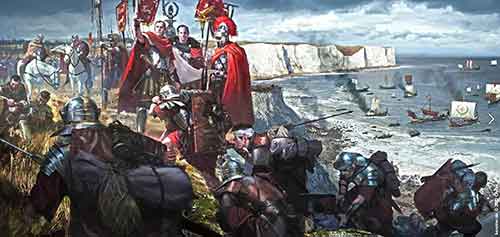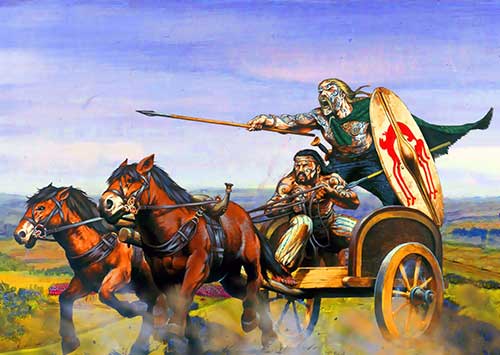The Second Roman Expedition (54 BC)
Preparation for the second expedition
Julius Caesar's plan for the expedition intended for the spring of 54 BC., was more detailed and had greater requirements than the first attempt. This time he planned to win.
Caesar's list:
- 600 transport ships of shallow draft
- 5 legions
- 2000 cavalry
The intentions for Caesar's second expedition are unclear. They could have been any combination of these :
- To conquer Britain and gain political control
- To punish the tribes for his defeat in the first expedition of the previous year. (Which he reported to Rome as a victory)
- To open up Britain for trade in goods in which Rome was in short supply
It may have been any one, or a combination, but Caesar was determined that this time he would succeed.
The landing

Caesar had established that a sneak attack using a suitable hidden harbour was not possible, as The South East part of Britain consisted of mainly sloping beaches. So a surprise assault was ruled out. In any case, the traders would have warned the Britons of the advancing army.
In the face of such a formidable force, the Britons did not offer much resistance this time. The Roman forces were able to disembark without any resistance. Being of shallow draft, the ships could sail close to the beach, and left riding at anchor.
Caesar marched his legions 12 miles inland in the dark of early morning to what was probably the River Stour near Canterbury.
The Britons must have been shocked at such an army and retreated back to a fortified position. In Caesar's own words :
'A place well fortified by nature and strengthened by artifice, built doubtless for their own tribal wars. All the entrances were blocked by felled trees packed closely together.'
The advance inland
The fort that Caesar refers to may well be three miles west of Canterbury in Bigbury Wood, near Hambledown. It is roughly rectangular. An enclosure constructed around the 200 foot contour.
While such defences were adequate to repel raiding bands from local tribes, they were no match for the might of this Roman force. The legionaries were disciplined and trained to storm stronger defences. Legio VII quickly built a ramp against the side of the fort and formed a testudo by raising their shields above their heads, to form a solid barrier to the missiles that were most certainly raining down upon their position. They hacked their way into the fort, driving the Britons that were within, out into the woods. This whole battle took the best part of a day, and as his men needed rest, Caesar built a fortified position and allowed his army to rest until the next morning.
Once again the British weather worked against Caesar, because while the soldiers rested, a powerful storm had severely damaged the Roman fleet at anchor off the coast. This meant Caesar could not advance as planned, but had to return to make necessary repairs to his vessels.
The retreat to the coast and the defence
The army worked day and night to drag the boats onto the beach and into a fortified position that they had built. They then set about the task of making repairs.
This lost time and subsequent delays cost Caesar the resounding victory he had planned for. By this time, Caesar felt, that he and his army would have swept across the lands, past the Thames and obliterating all in their path.
By this time, many of the British tribes had formed an alliance as this was the only way that they might would be able to battle effectively against this Roman army. Differences between the tribes had been put aside, as unity and strength in numbers was paramount. They had even appointed a supreme commander, Cassivellaunus, a chief of lands with a boundary on the north bank of the Thames.
There followed a few minor battles, until Caesar sent 3 legions with cavalry support in a charge against these combined forces. By now the Britons realised that this was a more determined, and better organised expedition that the one from the previous year. The tribes retreated to the woodlands north of the Thames. In their rivers, the Britons had placed underwater defences. Sharpened wooden spikes fixed at an angle to impale any swimmer who may try to cross. The Roman army however, had been trained for these types of defences and so, they and the cavalry managed to cross the river with little trouble. Once across they continued pushing the Britons even further northwards.
 Cassivellaunus realised that his makeshift army of tribes was no match for this mighty Roman force, so he devised
an alternative plan. He withdrew his forces and kept only 4000 charioteers to harass the Roman flanks and
rear. This was not intended as an attack, merely a diversion, to slow the Roman advance while Cassivellaunus
moved the inhabitants from the invaders path, along with the cattle. This prevented many Britons from being
captured and used as slaves and also denied the Romans food in the form of British livestock. It worked, as this
resulted in a stalemate between the two forces.
Cassivellaunus realised that his makeshift army of tribes was no match for this mighty Roman force, so he devised
an alternative plan. He withdrew his forces and kept only 4000 charioteers to harass the Roman flanks and
rear. This was not intended as an attack, merely a diversion, to slow the Roman advance while Cassivellaunus
moved the inhabitants from the invaders path, along with the cattle. This prevented many Britons from being
captured and used as slaves and also denied the Romans food in the form of British livestock. It worked, as this
resulted in a stalemate between the two forces.
The second advance
Then Caesar turned the battle in his favour by using one of the tribe members. A young prince of the Trinovantes had gone to Gaul to seek the protection of Caesar. His father had been slain by Cassivellaunus. This meant that Julius Caesar now had a valuable ally who held influence in the Essex area of England. Through the prince, he persuaded the Trinovantes to not only supply food to his Roman army, but also to surrender to Rome. These tribes were the Cenimagni, Segontiaci, Ancalites, Bibroci and the Cassi. These people were part of tribes that bordered on Cassivellaunus' kingdom. Apart from the Cenimagni, who were probably the Iceni, little is known of the other tribes. They informed Caesar were Cassivellaunus had placed his camps, which were duly raided by the Romans. The Britons that were not killed, fled to the woodlands and the Romans captured the cattle that were stored in these camps and so won a major victory in their campaign.
In a last desperate attempt to battle the Romans, the Kent tribes launched an assault on the Roman camp on the Kent coast, in an attempt to cut the Romans connection with Europe and strand them in Britain. A battle between these tribes and the Romans ended with a retreat by the Britons.
Cassivellaunus was in a total lose situation and so he approached Caesar with the intention of forging a peace between the two sides. Commius was sent to act as the negotiator.
The final Roman retreat
It is at this point that Caesar received news of serious trouble in Europe which meant he had to return. Before leaving Caesar took hostages, set an annual tax for the tribes to be paid to Rome and instructed Cassivellaunus not to invade the Trinovantes, who had betrayed him . The decision to leave Britain was so sudden Caesar had to wait a short time for ships to arrive from Gaul to ferry his troops back over, before using his own ships. In the autumn of 54 BC. The Romans left Britain.
Although he had taken a vast area of land in Britain, it was apparent that Caesar had not taken the time to examine his enemy before the expedition. In this case, it was not only the British people he had underestimated, but also the sea.




















